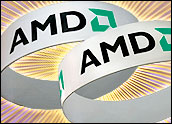
Two major chipmakers said Friday they had received subpoenas from antitrust investigators focusing on the market for graphics processing units and related chipsets.
Both AMD and Nvidia announced they had received the subpoenas early Friday and both said they planned to cooperate with investigators from the San Francisco Office of the Antitrust Division of the U.S. Department of Justice (DOJ).
Not Targets Yet
The companies also emphasized that they were not aware of any specific allegations having been made against them.
Still, investors appeared unnerved by the moves, likely because Nvidia is a market leader in the stand-alone graphics chip business, and ATI, which AMD acquired in October, has a strong foothold in the market for chips that support gaming and other graphics-intensive uses.
Shares of Nvidia were down more than 3.7 percent in Friday, trading to US$35.60; AMD’s stock also fell, losing 3.5 percent to $20.80.
Intel said as of Friday it was not aware of having received a similar subpoena.
The subpoenas appear to confirm that the DOJ is now looking into how chipmakers sell graphics chips. That would add to ongoing investigations into the markets for DRAM (dynamic random access memory) and SRAM (static random access memory) chips, which have involved both U.S. and international companies.
Welcome to the Biz
For AMD, the subpoena is a sort of welcome wagon gift. The number two chipmaker behind Intel, AMD entered the graphics processor business just over a month ago when it closed its $5.4 billion acquisition of ATI Technologies.
AMD said the subpoena does not appear to allege any wrongdoing by ATI before it was acquired, as well.
The apparent investigation comes just a few weeks after the DOJ cleared the way for the AMD purchase of ATI. It is possible that the DOJ may have turned up information in that review that it feels warrants an additional look.
Unlike the market for PC processors, where Intel remains a dominant force with an 80 percent market share, the market for graphics processors is more balanced. If all chipsets and bundles are counted, Intel controls about 50 percent of the market, and Nvidia holds a modest lead for second place in terms of market share over the combined product lines of AMD and ATI.
However, Nvidia dominates the market for stand-alone graphics chips and video cards, currently at about 55 percent, according to data from Mercury Research.
Though it’s not the largest, Nvidia has earned a solid reputation for producing strong graphics processors, which are becoming increasingly sought-after as PC and console gaming stretches the limits of existing technology. Depending upon their use, graphics chips and video cards can sell for between $50 and $500 each.
Nvidia’s GeForce and nForce brands are often sought out specifically by hard core gamers, who ensure the chips are installed on PCs before they buy them.
Familiar Refrain
Antitrust questions have dogged the chip-making industry for more than a decade. Intel, which was investigated and eventually cleared by the DOJ in the 1990s, has also been under scrutiny in Europe. Last year, European investigators raided the company’s regional offices and offices of PC makers, apparently in search of information on possible price fixing or other antitrust tactics.
Earlier investigations into price-fixing and collusion have led to fines and penalties. For instance, the inquiry into DRAM price-fixing led to executives from Samsung, Hynix and other companies paying stiff fines or being sentenced to jail.
One trend in the industry is to integrate graphics chips with other processors, Gartner analyst Brian Gammage said. Intel has long done so, and AMD’s purchase of ATI was aimed at matching that offering.
Integration enables chipmakers to produce processors that are more energy efficient, extending battery life in notebooks, for instance.
It is unclear whether such a trend would be enough to spark an antitrust probe, however.
Gammage told the E-Commerce Times that the competition among ATI, Nvidia and others typically has kept graphics prices in check, though they do fluctuate based on spikes in demand.























































Social Media
See all Social Media